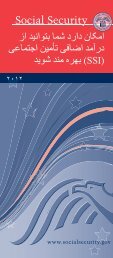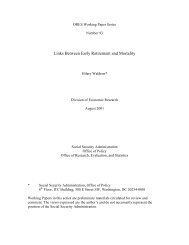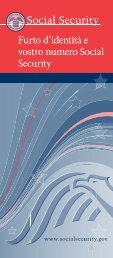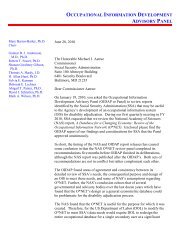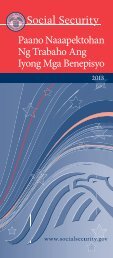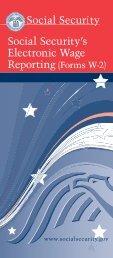(Cronin 1985). The final earnings records during thisperiod contained detailed quarterly and summaryearnings information on microfilm, including theclaim or disability status of the individual (SSA n.d.).Earnings information for individual workers up to theOASDI taxable maximum continued to be reportedquarterly by employers through 1977. 23 If an employeereached the taxable maximum during the year, theemployer was not required to report any informationon that employee in subsequent quarters. After 1951,if an employee’s combined wages from two or moreemployers exceeds the taxable maximum, the recordincludes wages exceeding the maximum. 24 However,for 1951 to 1977, only the total annual earningsamount is contained in the MEF; in later years, theamounts for each employer are also available. Similarly,earnings from self-employment were added toany employee wages and recorded as a yearly total inthe MEF during this period.Total QCs and the quarterly pattern in which wageswere earned are also available for each year of data;however, QCs were allocated by different methods,depending on the type of earnings, during this period.For covered wages and tips, a QC was credited foreach quarter in which the employee had $50 or morein earnings, up to four QCs a year. An employee withmaximum covered earnings was credited with fourQCs for the year. A self-employed individual wouldreceive a QC for each $100 of self-employed income,up to four QCs a year; and a QC was allocated foreach $100 of agricultural earnings (SSA 2008). 251978 to date. Under P.L. 95-216, beginning in 1978,SSA began collecting wage and salary informationdirectly from employers on the Form W-2 Wageand Tax Statement on an annual basis. This reducedprocessing delays and the administrative burdens ofreporting and collecting information quarterly. Theswitch to Form W-2 also meant that SSA had accessto information, such as wages above the taxablemaximum and wages from noncovered employment, ithad not previously received. By the late 1970s, electroniccapabilities had increased dramatically fromthe original punch cards and magnetic tape used bySSA, enabling the agency to store the additional W-2information (see the Data Available section for the fulllist of variables contained in the MEF today). In 1978,most W-2 information was received in paper formand was keyed into the SSA earnings record systemon magnetic tape at three data keying centers (Cronin1985). As more employers began to submit their wagereports via electronic media, only one data processingcenter was needed. Today, employers can go directlyto SSA’s Business Services Online 26 to submit W-2selectronically and to request verification of employees’names and SSNs through the <strong>Social</strong> <strong>Security</strong> NumberVerification System. Although some earnings informationstill comes to SSA in paper form, 81 percentof W-2s in fiscal year 2007 were filed electronicallyby employers, thus reducing the administrativecosts of entering and maintaining the earnings data(SSA 2007).A QC was earned for each $250 of reported coveredearnings from all sources (such as wages, tips, andself-employment) up to the annual limit of four in1978. Since 1979, the amount of earnings needed foreach QC has increased annually, proportional to thenational average wage. In 2009, a QC is earned foreach $1,090 of covered earnings.Posting ProcessBefore posting earnings data to an individual’s record,SSA verifies that the name and SSN on the W-2 orself-employment income report match information inits Numerical Identification (Numident) file. Recordsin the Numident are established when an individualapplies for an SSN by filling out an SS-5 form. 27 SSAenters information from the SS-5 into the Numidentfile, which contains each person’s name, SSN, sex,self-reported race, birth date, and place of birth.Numident records are updated when an individualreports a name change (usually from marriage),requests a correction, asks for a replacement for a lostcard, or dies. Verification and date of death comesfrom state vital records or from public reporting(claimants, family members, or funeral homes) and isstored in a separate record.SSA receives information on employee wages fromthe employer on Form W-2 Wage and Tax Statementand Form W-3 Transmittal of Wage and Tax Statements,and on self-employment earnings from IRSdata files derived from Schedule SE and the unreportedwages and tips line item on Form 1040, U.S.Individual Income Tax Return. 28 Form W-2 currentlycontains the following information:• Employee’s SSN• Employer identification number (EIN)• Employer’s name, address, and ZIP code• Employee’s name and address• Wages, tips, and other compensation• Federal income tax withheld36 <strong>Social</strong> <strong>Security</strong> Bulletin • Vol. 69 • No. 3 • 2009
• <strong>Social</strong> <strong>Security</strong> wages• <strong>Social</strong> <strong>Security</strong> tax withheld• Medicare wages and tips• Medicare tax withheld• <strong>Social</strong> <strong>Security</strong> tips• Allocated tips• Advance earned income credit (EIC) payment• Dependent care benefits• Nonqualified plan distributions• Codes for reporting types of deferred compensation• Checkboxes for statutory employee status, retirementplan participation, and third-party sick paydisburser status• State and local income tax informationSSA stores some of the W-2 information as administrativedata; most of it is sent to the IRS.The W-3 is a summary form that contains aggregateearnings information for all employees in the wagereport. For SSA to accept the wage amounts on theW-2s, their cumulative total must agree with the W-3.If the data files from these forms balance against oneanother, the information can then be posted to individualearnings records. SSA receives informationfrom employers and the IRS continuously; thereforethe MEF is updated on a weekly basis.Each year, SSA processes about 245 millionemployee wage reports submitted by about 6.9 millionemployers (SSA 2009d). As noted earlier, in order forthe earnings on these wage reports to be posted to theMEF, the combination of the name and SSN on FormW-2 must be matched to the Numident. 29 If eitheris different, SSA applies over 20 separate computerroutines and other techniques to attempt to findmatches for the initial mismatches. Approximately90 percent of the wage reports received by SSA eachyear are posted to the MEF without difficulty. Afterthe computerized routines are applied, approximately96 percent of wage items are successfully posted to theMEF (GAO 2005).If the name and SSN do not match, even after SSAhas performed its computer matching routines, thewages can not be credited to the individual’s account.Instead, the earnings are placed in the EarningsSuspense File (ESF). The ESF retains unposted itemsuntil they can be correctly assigned and placed in theMEF with a valid name and SSN. 30 SSA performsadditional operations annually to further attempt tomatch earnings to individuals’ records. To ensurethat workers have an opportunity to correct anydiscrepancies in their earnings records, SSA has since1979 sent letters to all employees whose names andSSNs can not be matched. In 1994, SSA began alsoto send letters to employers who submit more than10 W-2s with nonmatching names and SSNs, whenthese represent more than 0.5 percent of the W-2s theysubmit. 31 Additionally, beginning in 2000, all workersand former workers aged 25 or older receive anannual <strong>Social</strong> <strong>Security</strong> Statement that lists by year all<strong>Social</strong> <strong>Security</strong> and Medicare earnings that have beenposted to the MEF to date. 32 These statements haveled to earnings being corrected at earlier ages, whenworkers can provide evidence of the wages missingfrom or erroneously posted to their record. Remainingdiscrepancies can be corrected at the time of benefitapplication, when individuals scrutinize their earningsrecords to ensure all their earnings are being used tocalculate their monthly benefit amount.As of October 2007, 275 million wage items fortax years 1937 to 2005 were in the ESF, amounting to$661 billion in wages for which <strong>Social</strong> <strong>Security</strong> taxeshave been paid (SSA 2009b). Because SSA maintainsthese data for a long time, individuals with legitimateearnings missing from their earnings records can havethem properly posted (there may also be legitimateearnings missing from earnings records that are notin the ESF). 33 Researchers using the MEF shouldunderstand that earnings records could be incompleteor contain extraneous earnings for certain individuals,and that there is no indicator to warn that an individual’searnings record is erroneous.Data AvailableOnce SSA confirms that the employer- and IRSreportedname and SSN of a worker match thoserecorded in the Numident, his or her earnings areposted to the MEF Earnings Detail Segment, and theMEF Summary Segment is updated (Panis and others2000). 34 The Summary Segment contains annualOASDI-taxable wages and tips and self-employmentearnings from 1951 to the present; cumulative taxableearnings for 1937–1950, 1951–1977, and 1978to date; annual information on MQGE from 1983 todate; cumulative QCs for 1947–1950 and 1951–1977;annual QCs for 1951–1977 (QCs from 1978 to date arecomputed using reported earnings); and railroad andmilitary earnings indicators. 35 The Summary Segmentalso includes variables such as SSN, race, sex,date of birth, date of death, 36 an indicator of earnings<strong>Social</strong> <strong>Security</strong> Bulletin • Vol. 69 • No. 3 • 2009 37
- Page 1 and 2: Social SecuritySocial SecurityBulle
- Page 3: Social SecurityBulletin Vol. 69, No
- Page 6 and 7: Perspectives77 An Empirical Study o
- Page 8 and 9: Selected Abbreviations—continuedM
- Page 10: within the next few years (Aglira 2
- Page 14 and 15: coverage varies significantly by ra
- Page 16 and 17: non-Hispanic white, and college edu
- Page 18 and 19: same groups (Table 6). For the last
- Page 20 and 21: from DB to DC pensions is accelerat
- Page 22 and 23: Table 8.Percent of individuals who
- Page 24 and 25: not necessarily the largest gains a
- Page 26 and 27: shoring-up DB plans before those pl
- Page 28 and 29: Table B-1.Percent change in mean pe
- Page 30 and 31: Table B-3.Percent of individuals wh
- Page 32 and 33: ReferencesAaronson, Stephanie, and
- Page 35 and 36: Social Security Administration’s
- Page 37: Chart 1.Historical expansion of Soc
- Page 40 and 41: self-employment information for the
- Page 44 and 45: prior to 1950, first year of earnin
- Page 46 and 47: average indexed monthly earnings (A
- Page 48 and 49: 13For an explanation of how the sel
- Page 50 and 51: Kopczuk, Emmanuel Saez, and Jae Son
- Page 53 and 54: Occupations of SSI Recipients Who W
- Page 55 and 56: on the differences between the occu
- Page 57 and 58: prediction models. Table A-1 lists
- Page 59 and 60: Occupational Distributions of theEm
- Page 61 and 62: similar, only 4 percent of the popu
- Page 63 and 64: Table 5.Estimated occupational dist
- Page 65 and 66: Table 7.Predicted Herfindahl-Hirsch
- Page 67 and 68: Table 9.Estimated occupational dist
- Page 69 and 70: Table 11.Average annual wages of wo
- Page 71 and 72: Table A-2.Means and standard errors
- Page 73 and 74: Table A-3.Coefficients and standard
- Page 75 and 76: Table A-3.Coefficients and standard
- Page 77 and 78: Table A-3.Coefficients and standard
- Page 79 and 80: management, professional, and relat
- Page 81: Stapleton, David C., Nanette Goodma
- Page 84 and 85: Selected Abbreviations—continuedO
- Page 86 and 87: The 1983 Amendments to the Social S
- Page 88 and 89: Chart 1.Proportion of new claimants
- Page 90 and 91: Table 4.The evolution of the ARF an
- Page 92 and 93:
for the test of equality of means b
- Page 94 and 95:
Table 8.Average monthly Social Secu
- Page 96 and 97:
in the chart, especially for men, t
- Page 98 and 99:
6This is a very important character
- Page 100 and 101:
Benítez-Silva, Hugo, Berna Demiral
- Page 103 and 104:
OASDI and SSI Snapshot andSSI Month
- Page 105 and 106:
Monthly Statistical Snapshot, Augus
- Page 107 and 108:
Table 2.Recipients, by eligibility
- Page 109 and 110:
SSI Federally Administered Payments
- Page 111 and 112:
Table 7.Average monthly payment, by
- Page 113:
Awards of SSI Federally Administere
- Page 116 and 117:
Copyright—Authors are responsible
- Page 119 and 120:
Program Highlights, 2009Old-Age, Su



